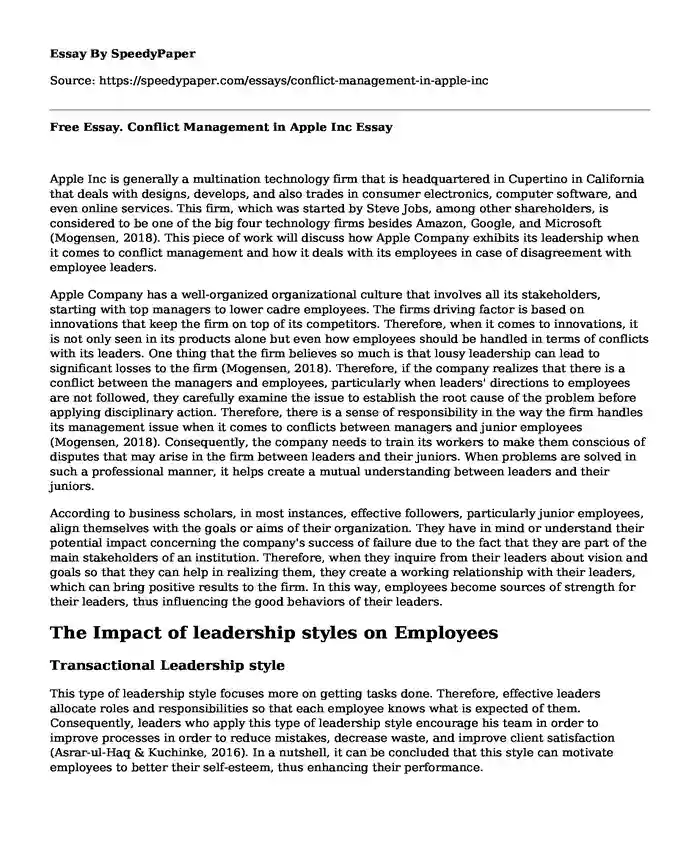
| Type of paper: | Essay |
| Categories: | Human resources Organizational culture Conflict management Leadership style |
| Pages: | 3 |
| Wordcount: | 695 words |
Apple Inc is generally a multination technology firm that is headquartered in Cupertino in California that deals with designs, develops, and also trades in consumer electronics, computer software, and even online services. This firm, which was started by Steve Jobs, among other shareholders, is considered to be one of the big four technology firms besides Amazon, Google, and Microsoft (Mogensen, 2018). This piece of work will discuss how Apple Company exhibits its leadership when it comes to conflict management and how it deals with its employees in case of disagreement with employee leaders.
Apple Company has a well-organized organizational culture that involves all its stakeholders, starting with top managers to lower cadre employees. The firms driving factor is based on innovations that keep the firm on top of its competitors. Therefore, when it comes to innovations, it is not only seen in its products alone but even how employees should be handled in terms of conflicts with its leaders. One thing that the firm believes so much is that lousy leadership can lead to significant losses to the firm (Mogensen, 2018). Therefore, if the company realizes that there is a conflict between the managers and employees, particularly when leaders' directions to employees are not followed, they carefully examine the issue to establish the root cause of the problem before applying disciplinary action. Therefore, there is a sense of responsibility in the way the firm handles its management issue when it comes to conflicts between managers and junior employees (Mogensen, 2018). Consequently, the company needs to train its workers to make them conscious of disputes that may arise in the firm between leaders and their juniors. When problems are solved in such a professional manner, it helps create a mutual understanding between leaders and their juniors.
According to business scholars, in most instances, effective followers, particularly junior employees, align themselves with the goals or aims of their organization. They have in mind or understand their potential impact concerning the company's success of failure due to the fact that they are part of the main stakeholders of an institution. Therefore, when they inquire from their leaders about vision and goals so that they can help in realizing them, they create a working relationship with their leaders, which can bring positive results to the firm. In this way, employees become sources of strength for their leaders, thus influencing the good behaviors of their leaders.
The Impact of leadership styles on Employees
Transactional Leadership style
This type of leadership style focuses more on getting tasks done. Therefore, effective leaders allocate roles and responsibilities so that each employee knows what is expected of them. Consequently, leaders who apply this type of leadership style encourage his team in order to improve processes in order to reduce mistakes, decrease waste, and improve client satisfaction (Asrar-ul-Haq & Kuchinke, 2016). In a nutshell, it can be concluded that this style can motivate employees to better their self-esteem, thus enhancing their performance.
Autocratic leadership style
This is a leadership style that lacks democracy, in which those leaders command their teams throughout without giving an ear to dissenting opinions from junior staff. This type of leadership discourages employees and subsequently affect employees' behaviors negatively, thus lowering their performance (Asrar-ul-Haq & Kuchinke, 2016). In such a scenario, companies lose employees if such a leadership style is implemented.
Ideally, for a company like Apple Inc to improve employees' future training, it needs to be objective and be up to date when it comes to employees' skills. For instance, Apple is more into innovations than any other factor since, according to them, innovation keeps them moving (Asrar-ul-Haq & Kuchinke, 2016). Therefore, it needs to execute strategies that are futuristic in that, employees will have skills that can live in this era of progressive technological advancement. In conclusion, the cultivation of a good working relationship between workers and employees is key to a company's successful future.
References
Asrar-ul-Haq, M., & Kuchinke, K. P. (2016). Impact of leadership styles on employees' attitude towards their leader and performance: Empirical evidence from Pakistani banks. Future Business Journal, 2(1), 54-64.
Mogensen, B. G. (2018). Managing Corporate Legitimacy Through CSR Reporting: A Qualitative Case Study of Apple Inc.'s Supplier Responsibility Reports (Master's thesis).
Cite this page
Free Essay. Conflict Management in Apple Inc. (2023, May 17). Retrieved from https://speedypaper.com/essays/conflict-management-in-apple-inc
Request Removal
If you are the original author of this essay and no longer wish to have it published on the SpeedyPaper website, please click below to request its removal:
- Free Essay Sample on Domestic Workers
- Personal Essay Example on The Waves Knock Over
- Essay Sample Defining Organizational Psychology and Leadership
- Affordances - Essay Sample
- Essay Example: Ethiopian Restaurant Experience
- Essay Example on the Issues Affecting Countries and the Aspects of Economic Growth
- Essay Example: The Skills And Roles Of A Manager In Crisis Management
Popular categories




